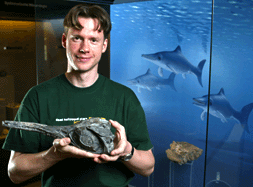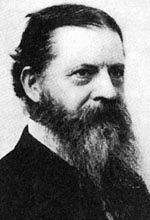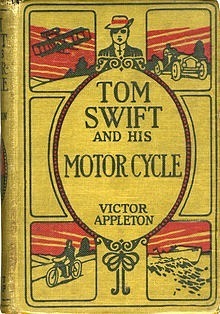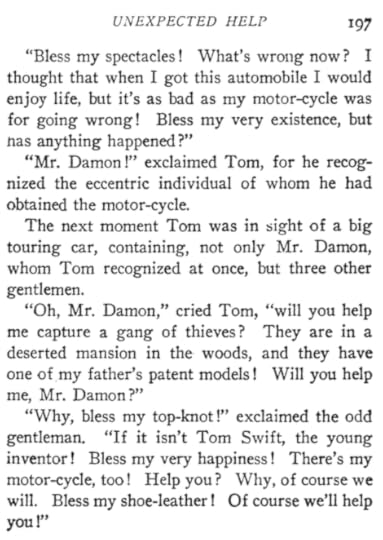Marc Abrahams's Blog, page 596
February 13, 2012
The vertical fossil and the exploding ichthyosaur theory
Ancient seagoing animals did not explode nearly as often as scientists believed, according to a new study called Float, Explode or Sink: Postmortem Fate of Lung-breathing Marine Vertebrates.
 The authors, an all-star team of palaeontologists, pathologists and forensic anthropologists [one of them, Achim Reisdorf, is pictured here] from six institutions in Switzerland and Germany, deflated a hypothesis that had for years lain basking in the sun.
The authors, an all-star team of palaeontologists, pathologists and forensic anthropologists [one of them, Achim Reisdorf, is pictured here] from six institutions in Switzerland and Germany, deflated a hypothesis that had for years lain basking in the sun.
They were addressing the underlying question: why are some ichthyosaur skeletons scattered across an expanse of sea floor, while others remain fairly intact?
The current adventure started with the discovery of an ichthyosaur skeleton, embedded in rock, in northern Switzerland. This skeleton was oriented weirdly, compared with most such fossils: aligned vertically, with its head down, its feet up.
Someone hypothesised that "an explosive release of sewer gas" had "propelled the skull into the sediment"….
So begins this week's Improbable Research column in The Guardian.
BONUS: For something completely different—an upside-down, head-exploding take on this same subject—behold this video:

Liverpudlian Valentine's Day Disco Debacle
Liverpool's great Valentine Disco Debacle happened in 2008, and is commemorated in a medical journal report:
"The University Rollerdisco: An unusual cause of a major incident," A.J. Highcock, K. Rourke and D. Brown, Injury Extra, volume 39, issue 12, December 2008, Pages 386–388.
"Rollerdisco's are associated with a high incidence of injury, as is binge drinking. On Valentine's evening 2008, Liverpool University combined these two venerable pastimes at a student event, without informing local health services. Subsequently, emergency services were overwhelmed with Rollerdisco casualties and a 'major incident…. The event itself consisted of a newly laminated hall for roller skating, alcoholic drink promotions and a 1980s themed dress code. Certainly the Accident and Emergency Department became a colourful place with variously injured patients in flamboyant dress and in a generally 'exuberant' mood. In all, eight patients were admitted (one patient for every 17 min of the disco)."

February 12, 2012
Shuttlecock Aerodynamics (Part 2)
[This part 2 of a series] The 2009 work of Firoz Alam, Harun Chowdhury, Chavaporn Theppadungporn, Aleksandar Subic, and M. M. K. Khan (on the aerodynamics of shuttlecocks) has been complemented by a new study from LadHyX*, Palaiseau, France.
"
We study experimentally shuttlecocks dynamics. In this part we show how the shuttlecock shape is optimized for badminton play. The shuttlecock always flies the nose forehead. After the impact it has thus to return. Actually it returns, oscillates and then stabilizes. We try to understand these damping oscillations and draw an analogy with the dandelions achenes and parachutists."
Physics of badminton shuttlecock. Part 2: Turn around was presented at the 64th Annual Meeting of the APS Division of Fluid Dynamics, General Fluid Dynamics III, 12:50 PM–3:00 PM, Tuesday, November 22, 2011.
Note: LadHyX are also noted for their work on teapot spout drip avoidance

February issue of mini-AIR
 The February issue of mini-AIR just went out. Topics include:
The February issue of mini-AIR just went out. Topics include:
Inaccurate Children
Meal Order Reversal / Candy Limerick Competition
Sandwich Crawler Poet
Ultrastructure of a Copepod Fecal Pellet
Chopsticks / Moving Beans Test / Purdue Pegboard
and more
Mel [pictured here] says, "It's swell."
(mini-AIR is the simplest way to keep informed about Improbable and Ig Nobel news and events. Just specify your email address, and mini-AIR will be emailed to you every month)

Improbable Research @ AAAS in Vancouver Saturday
Please join us Saturday night, February 18, at 7:00 pm for the annual Improbable Research show at the AAAS annual meeting. Details:
AAAS Annual Meeting, Vancouver, British Columbia, Canada. Fairmont Waterfront Hotel, Mackenzie Room. Featuring:
Marc Abrahams, Improbable Research editor and founder of the Ig Nobel Prize ceremony
John Senders of the University of Toronto, 2011 Ig Nobel public safety prize winner, will do two brief talks — one about his driving-on-a-highway-with-eyes-covered experiment [see historical video of it, below], the other about an unpublished gunslinger experiment he did in 1956
Yoram Bauman, performing economist
Ivan Oransky , co-founder of Retraction Watch , will describe the year's most memorable and provocative retractions
Sydney Fels of the University of British Columbia will demonstrate how computers can automatically turn a person's gestures into speech
and others to be announced.
This event, unlike most of the AAAS Annual Meeting, is open free to the public. #AAASmtg
BONUS: Complete schedule of upcoming Improbable events

Finding an optimal seating chart for a wedding
by Meghan L. Bellows (Department of Chemical and Biological Engineering, Princeton University) and J.D. Luc Peterson (Princeton Plasma Physics Laboratory, Princeton University)
EDITOR'S NOTE: The authors submitted this article long prior to the wedding. Somehow we managed to not see it until long after. The only benefit being that the article can and does include photographs taken at the wedding. We are delighted to publish it here, online.
Every year, millions of brides (not to mention their mothers, future mothers-in-law, and occasionally grooms) struggle with one of the most daunting tasks during the wedding-planning process: the seating chart. The guest responses are in, banquet hall is booked, menu choices have been made. You think the hard parts are over, but you have yet to embark upon the biggest headache of them all. In order to make this process easier, we present a mathematical formulation that models the seating chart problem. This model can be solved to find the optimal arrangement of guests at tables. At the very least, it can provide a starting point and hopefully minimize stress and arguments… [ Read the entire article in PDF form ]


February 11, 2012
Tom Swift and the blessings of invention
 The Tom Swift books introduced young folks to inventions and scientific research. The original series was written in the early 1900s. Later series, featuring the offspring of the original characters, introduced different generations to much later technologies and discoveries. The books were written in a sort of industrial fashion, by the pseudonymous Victor Appleton. (One must not confuse him with the British physicist Edward Victor Appleton, especially when one visits the Appleton Tower at the University of Edinburgh.)
The Tom Swift books introduced young folks to inventions and scientific research. The original series was written in the early 1900s. Later series, featuring the offspring of the original characters, introduced different generations to much later technologies and discoveries. The books were written in a sort of industrial fashion, by the pseudonymous Victor Appleton. (One must not confuse him with the British physicist Edward Victor Appleton, especially when one visits the Appleton Tower at the University of Edinburgh.)
Tom Swift was a boy inventor (one must not confuse him with Tom Swift, the Australian footballer, especially when visiting Western Australia).
One of the minor characters, a helpful grown-up named Mr. Damon, had a colorful habit of speech. To express excitement, or because he simply could not do otherwise, Mr. Damon blessed whatever came to mind. This page —page 197— from Tom Swift and His Motorcycle, which was published in 1910, shows Mr. Damon blessing everything from his spectacles and his existence to his shoe-leather:

How to manage invasive carp (2 methods)
There are several documented methods for managing invasive carp. Here's one, used in Australia:
"Managing invasive carp (Cyprinus carpio L.) for habitat enhancement at Botany Wetlands, Australia," L. Pinto, N. Chandrasena1, J. Pera, P. Hawkins, D. Eccles, R. Sim, Aquatic Conservation: Marine and Freshwater Ecosystems, Volume 15, Issue 5, pages 447–462, September/October 2005.
Here's another, used in the USA [HT metafilter]:

Pyramids can fly, under certain circumstances
Pyramids can fly, under certain circumstances. This new study explains:
"Intrinsic Stability of a Body Hovering in an Oscillating Airflow," Bin Liu, Leif Ristroph, Annie Weathers, Stephen Childress, and Jun Zhang, Physical Review Letters, 108, 068103 (2012). The authors, at New York University, explain that in their experimental setup [pictured below]:
"weight support and orientational stability result from the periodic shedding of vortices"

Industrial palaces are people, too [animation]
Henning Lederer made this animated version of Fritz Kahn's 1927 poster Der Mensch als Industriepalast [Man as Industrial Palace]
(HT Diana Issidorides)
BONUS (unrelated, probably): Man forced to eat his beard, he says:
(Thanks to investigator Dan Gallo for bringing this to our attention.)

Marc Abrahams's Blog
- Marc Abrahams's profile
- 14 followers


























